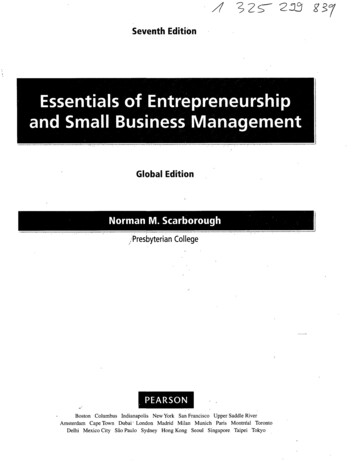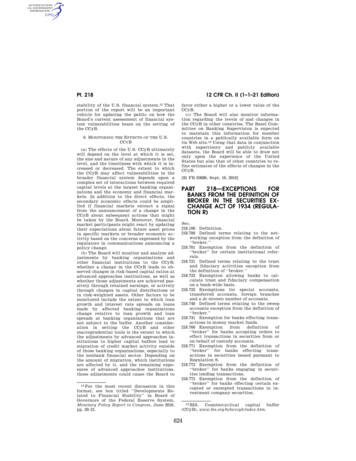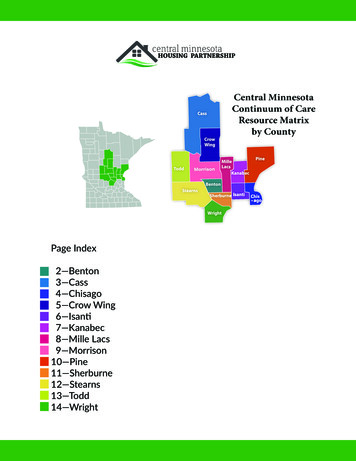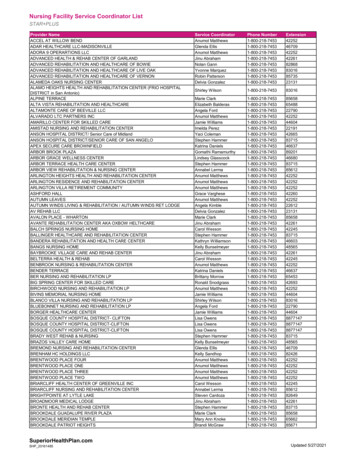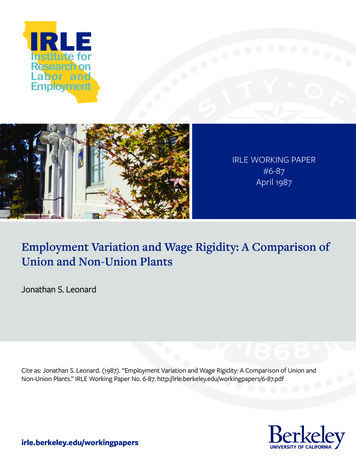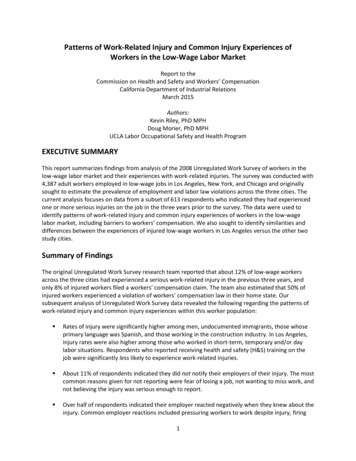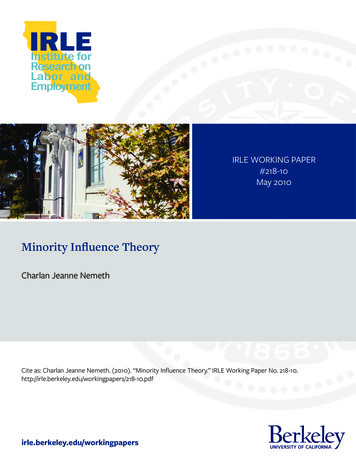
Transcription
IRLEIRLE WORKING PAPER#218-10May 2010Minority Influence TheoryCharlan Jeanne NemethCite as: Charlan Jeanne Nemeth. (2010). “Minority Influence Theory.” IRLE Working Paper No. 10.pdfirle.berkeley.edu/workingpapers
Institute for Research on Labor andEmploymentUC BerkeleyPeer ReviewedTitle:Minority Influence TheoryAuthor:Nemeth, Charlan Jeanne, University of California, BerkeleyPublication Date:05-08-2010Series:Working Paper SeriesPublication Info:Working Paper Series, Institute for Research on Labor and Employment, UC 1pz676t7Abstract:The study of minority influence began as reaction to the portrayal of influence as the provinceof status and numbers and from a realization that minorities need not just be passive recipientsof influence but can actively persuade. From these beginnings, a considerable body of research,including ours, has investigated how minority views prevail. . In the decades that followed, weconcentrated, not so much on persuasion or attitude change but, rather, on the value of minorityviews for the stimulation of divergent thinking. Dissent, as has been repeatedly documented,“opens” the mind. People search for information, consider more options and, on balance, makebetter decisions and are more creative. Dissenters, rather than rogues or obstacles, provide value:They liberate people to say what they believe and they stimulate divergent and creative thoughteven when they are wrong. The implications for group decision making, whether in juries orcompanies, have been considerable and there is increasing interest in research and in practicefor the value of authentic dissent in teams and in creating “cultures” of innovation.eScholarship provides open access, scholarly publishingservices to the University of California and delivers a dynamicresearch platform to scholars worldwide.
To appear in :Van Lange, P., Kruglanski, A. and Higgins, T. (eds) Handbook of Theoriesof Social Psychology. New York: Sage 2009, in pressMinority Influence TheoryCharlan Jeanne Nemeth 1,2University of California, BerkeleyAbstractThe study of minority influence began as a reaction to the portrayal of influence as theprovince of status and numbers and from a realization that minorities need not just bepassive recipients of influence but can actively persuade. From these beginnings, aconsiderable body of research, including ours, has investigated how minority viewsprevail. . In the decades that followed, we concentrated, not so much on persuasion orattitude change but, rather, on the value of minority views for the stimulation of divergentthinking. Dissent, as has been repeatedly documented, “opens” the mind. People searchfor information, consider more options and, on balance, make better decisions and aremore creative. Dissenters, rather than rogues or obstacles, provide value: They liberatepeople to say what they believe and they stimulate divergent and creative thought evenwhen they are wrong. The implications for group decision making, whether in juries orcompanies, have been considerable and there is increasing interest in research and inpractice for the value of authentic dissent in teams and in creating “cultures” ofinnovation.
Overview:My life long interest has been the study of influence --and in particular, influence bythose who hold minority opinions. Initially, we concentrated on how minorities “win” orpersuade others to their position. Stimulated by observations on juries, we recognized thepotential value of dissent, not for the truth that it holds or for its ability to persuade but,rather, for the thought that it stimulates. Repeatedly we found that dissent stimulatesthought that is more enquiring, more divergent and more creative. By contrast, majorityviews stimulate convergent thinking. People focus on the issue from the perspective ofthe majority and narrow the range of considerations, often convincing themselves of themajority position.This work has had influence on the dialogue within Social Psychology but also on thelaw as well as corporate cultures in organizations. Dissent has come to be seen as havingvalue and not simply as an “obstacle”. There is serious consideration of the importanceof protecting dissent in juries via procedural rules such as the requirement of unanimity.And, in organizations, the assumptions regarding the value of cohesion and homogeneityhave been complicated with a willingness to recognize the importance of diversity anddissent for innovation.Background:
As a graduate student in the mid ‘60s, I had the good fortune of studying with HenriTajfel and, through him, meeting Serge Moscovici (in England and France respectively)and, by virtue of their influence, I recommitted to the reasons why I decided to studySocial Psychology. As an undergraduate Math major, it was a single lecture onbrainwashing that motivated me to pursue graduate studies in Social Psychology; it wasthe simple but compelling observation that people are powerful sources of influence.They can educate, inspire and strengthen us or they can diminish and weaken us ashuman beings. Though graduate school proved to be disappointing with careful, highlychoreographed and often single variable studies, it was a “gap” year in Oxford thatrenewed my interests. Perhaps it took two Eastern European Jews who went throughWWII to teach me that we could and should study the combat between ideas and groups,that there were exemplars of courage and cowardice brought about by social conditionsand the influence of others.It was one year after my doctorate when, as a Visiting Professor in Bristol with Henriand in Paris with Serge that was to have the most influence on my thinking andsubsequent professional career. Henri was passionate about categorization and theimportance of ingroups and outgroups. Serge was rethinking the flow of influence.Social Psychology at that time portrayed influence as flowing from the strong to theweak. We learned the value of status, confident styles and numbers. High statusindividuals (or the perception of higher status) influenced those of lower status (Berger,Fisek, Norman, & Zelditch, 1977; Hovland, Janis, & Kelley, 1953). It was the white, tall,
wealthy, attractive male who studied at elitist institutions and/or who had position andtitle who influenced those of us who had few of those attributes or demographics. Peoplewho spoke loudly, quickly and with authority exercised influence (Giles, Bourhis, &Davies, 1979). And we certainly learned about the power of majorities. Faced with adisagreeing majority, even one that was wrong, people abdicated information from theirown senses and became subject to doubt (Asch, 1956; Kiesler & Kiesler, 1970). Theindividual or minority of individuals were passive agents. Their only choice seemed to beone of independence or conformity to the majority view.The power of these elements was true then and it is true now. However, not being in thecategories of status nor numbers in Psychology (who were predominantly male) norbeing particularly loud or authoritative, I can remember feeling relatively powerless inthe influence world. Much of the research, including that later embodied in social impacttheory (Latane, 1981) conveyed the imagery of a large truck that pummeled people intoacquiescence. Perhaps Tajfel and Moscovici and the students who were drawn to them inthose days identified with being in a minority and thus found appeal in a conception of anactive minority view, but it was also the world in which we found ourselves. During thatyear, Serge and I spent a lot of time discussing minority views and their power. He wouldoften tell me that American Social Psychology did not portray the world he saw. Theemphasis on winning friends and influencing people, reciprocating favors and continuallyresolving conflicts was in contrast to the experiences of his generation. Being 1970, itwas also in contrast to both his and my then recent experience. He went through the May’68 uprising which had lasting effects on the university and French society in general.
The year before, as a brand new Assistant Professor at the University of Chicago (1968),I saw in person a vigorous conflict of ideas about the Vietnam War. The anti-warminority did not conform or remain silently independent. They were vocal, persistentand aggressive –and there were violent consequences in response. We witnessed thebeatings, the “lessons” taught to faculty who supported those protests but we also sawsocial change and an evolution of public opinion that was dramatic.Shortly before, Serge along with Claude Faucheux developed a theory questioning theone-sided conceptualization of influence (Faucheux & Moscovici, 1967; Moscovici &Faucheux, 1972). Recognizing that social change cannot be understood without attentionto an initial minority view, they set out to demonstrate that minority views can prevail.As we had all witnessed, individuals and minorities were not simply passive agents whoeither resisted or conformed to majority judgments; they could in fact exercise influencethemselves. Furthermore, behavioral style is important and, in particular, consistencyover time is key to exerting influence. Not having the numbers or status to influence atthe outset, a member of a minority needed to argue his/her position effectively. It is theorchestration and patterning of verbal and non verbal behaviour that fosters influence(Moscovici & Nemeth, 1974). And in 1969, an experiment was able to demonstrate justsuch an effect (Moscovici, Lage, & Naffrechoux, 1969). That study and its findings havebeen replicated numerous times and provide, in my judgment, some of the best insightsinto why and how minorities can prevail. Thus it is worth describing in some detail.
In that study (which is almost a mirror image of a typical conformity experiment), 4naïve individuals and 2 confederates were shown a series of blue slides and were asked tojudge the color and the brightness of those slides. A control group consisting of onlynaïve individuals had no problem; they repeatedly called the blue slides “blue”. In theexperimental conditions, the 2 confederates offered a differing view. In the “consistent’condition, they repeatedly called the blue slides “green”. In other words, they said“green” on every trial. In the “inconsistent” condition, they called the slides “green” on2/3 of the trials and called them “blue” on l/3 of the trials.Most people –and certainly most students in my courses—hypothesize that theinconsistent condition would exert more influence. After all, they are correct on l/3 ofthe trials and, further, they agree with the majority on those trials and are thus likely to bebetter liked. The findings were the reverse. In keeping with the theory emphasizing theimportance of consistency, the findings showed that the consistent minority persuaded themajority to say “green” on nearly 9% of trials whereas the inconsistent minority exertedno influence, not differing statistically from the control group.Perhaps more importantly, the findings from this study showed that influence wasgreater at a private or latent level than evident at a public level. After the experimentalprocedure, individuals were asked to sort a series of blue/green chips into the categoriesof either “green” or “blue”. If you think of the colored chips you could find in a paintstore, you can order the blue/green chips along an actual physical dimension –from“blue” to “green”. You can mix up these chips but, at a point along that physical
dimension, individuals or a control group call those to the “blue end” of that point “blue”and to the “green end” of that point “green”. Experimental subjects in the consistentcondition shifted that point. They called the chips “green” when a control group wouldcall them “blue”. These two findings have stood the test of time.As I reflect back on conversations in those early years, Serge was very clear about theimportance of consistency—and the perils of compromise. He had a ratherpsychoanalytic view of influence. You had to combat the resistances. There was a war ofideas; there was conflict not easily resolved; and above all, there was clarity, even withexaggeration and omissionSerge behaved as he theorized and his lessons to me were personal as well asprofessional. He always put my feet to the fire. Whenever I would lapse in the graduatestudent habit of citing other people to legitimate my point, he would ask what I reallybelieved followed by “you must write that”.He convinced me that consistency and confidence were imperative. Know what youknow and speak what you believe. But in those observations, it also became clear thatinfluence involved “style over time” , that there was an orchestration of the verbal andnon verbal ways in which people interacted and persuaded. This stimulated an earlystudy showing that consistency could be maintained without the confrontation ofrepetition and increasing the conflict, provided that changes in position were due tochanges in the stimuli or “facts” (Nemeth, Swedlund, & Kanki, 1974). Above all, we
came to recognize that there was a subtlety about influence, a public face that oftenmasked what people really thought.Behavioural style:The early study demonstrating the importance of consistency over time has beenrepeatedly corroborated and developed (Moscovici & Lage, 1976; Moscovici & Nemeth,1974; Mugny, 1982; Nemeth, Mayseless, Sherman, & Brown, 1990; Nemeth, Swedlund,& Kanki, 1974). For the minority to be “persuasive”, they need to be seen as having aposition in which they believe. Minimally this means consistency of the position, notnecessarily repetition. Mugny has further pointed to the subtlety of consistency bymaking the distinction between flexibility and rigidity, the former but not the latter beingconducive to persuasion. Additionally, numerous studies have confirmed that minorityinfluence is aided by confident behavioural styles e.g. taking the head seat (Moscovici &Lage, 1976; Nemeth & Wachtler, 1974) or even by a perception of confidence whichmight occur by virtue of simply persisting as a minority voice (Nemeth, Wachtler, &Endicott, 1977). This area, in my judgment, is both fascinating and worthy of furtherdevelopment though the subtleties involved in the timing and choreography ofbehavioural style are challenging for researchers.The private or latent nature of influence:Perhaps the more important development from that early study is the fact that minorityviews exercise their influence at a private or latent level rather than in public. Even inour early discussions, it was clear to us that influence was deeper and more profound than
public adoption of a position. People may not publicly agree with the minority positionbut they may state it privately, later or in a different form (David & Turner, 2001; Mugny,Butera, Sanchez-Mazas, & Perez,1995; Nemeth & Wachtler, 1974). It may appear onindirect judgments or be generalized to other subjects (Forgas & Williams, 2001; Maass,West, & Cialdini, 1987; Mugny, 1982).Part of the reason for the “latent” influence by minorities is that people do not want topublicly move to a minority view since they fear the likely ridicule and rejection,consequences that have been documented since the early work by Schachter (1951).In one of our own studies (Nemeth & Wachtler, 1974), we saw very clearly howadamantly subjects would resist any public movement to a minority position. The settingwas a mock jury involving a personal injury case. The case was hypothetical-- but theanger was so evident that subjects were pounding their fists on the table next to theconfederate’s face (the one who argued a minority position on compensation). Thesubjects did not move one cent in public. Yet, their judgments shifted dramatically onpost-experiment questionnaires both on the case they had discussed and also on newcases with new facts. It was a demonstration of strong resistance against any publicagreement with minority views coupled with change at a latent level. It also made usrevise our compensation to include “combat pay” for the confederate.Mugny and his colleagues have elaborated the reasons for this reluctance to publiclymove to the minority view by invoking considerations of social identity and the desire to
belong (Butera & Mugny, 1995; Butera & Mugny, 2001; Mugny et al., 1995). Otherconsiderations have been ingroup and outgroup status. Almost all researchersdemonstrate that there is more discomfort and anger (Philips, 2003) when the holder of aminority view is a member of one’s ingroup rather than a member of an outgroup. Andthis discomfort may be one of the reasons why many studies show influence is greaterfrom an ingroup member (Crano, 2000; David & Turner, 1996; Volpato, Maas, MucchiFaina & Vitti, 1990). Discomfort may be a catalyst for further assessment of the message.Such findings make it clear that it is not easy to maintain a minority viewpoint. Angerand the perceptions of being unintelligent (or worse) are a predictable consequence(Levine, 1989). However, people who persist in a minority view can also be accorded theperceptions of confidence and courage which can be assets in their attempts to influence(Nemeth & Chiles, 1988; Nemeth, Wachtler, & Endicott, 1977). This is still an unchartedarea of research –why would anyone maintain a dissenting viewpoint given theconsequences—but fortunately, it is starting to be investigated (DeDreu, DeVries,Franssen, & Altink, 2000; LePine & Van Dyne, 2001).Moving to Influence as a Stimulant to ThoughtLearning that influence may occur at a private or latent level, even if not observable inpublic helped us to question the paradigms used to study attitude change. The fieldconceptualized influence to be attitude change on a Likert scale. If the target movedalong that scale to the position of the source, that was influence. Yet, we had increasing
evidence that attitudes could change on other dimensions or on other related issues. Butconvincing researchers to broaden the definition of influence was not easy as it seemed.Yet, we were convinced that influence was far more subtle and deeper than movement ona Likert scale. It was perhaps a recognition of this possibility plus the fact that dissent hadits power at the latent level that was to prime me for the observations that would come todominate my professional life-- and ironically to bring me back to the reasons why Idecided to study Social Psychology.My own early work on minority influence— the first 5 years post PhD-- was consumedwith understanding when, how and why minority views can prevail. A number of us whohad studied with Moscovici had become a cohesive and determined minority ourselvesand had documented and elaborated the power of the minority to persuade—to “win”.And we were finding converts to that field of research, initially with a wave of secondgeneration researchers. However, in 1974, my focus started to shift, much of it owing toan abiding interest in jury deliberations. Jury decisions were often the “task of choice” inmy experimental studies but it started to become a research interest in and of itself whileat the University of Virginia.The Supreme Court had recently ruled that a requirement of non-unanimity in jurydecisions did not violate the defendant’s constitutional rights (Apodaca, Cooper, &Madden, 1970; Johnson v. Louisiana, 1970). Oregon permitted a 10-2 verdict andMessrs. Apodaca, Cooper and Madden were convicted by 10-2 or 11-1 verdicts. InLouisiana, crimes subject to hard labor were allowed a 9-3 verdict and Mr. Johnson was
convicted by such a vote. All of these individuals thus appealed their convictions basedon a violation of the 6th and 14th amendments. Under “equal protection of the law”, forexample, their verdicts would have had to be unanimous had they been tried in anotherstate. The Court, however, ruled that their rights had not been violated and essentiallyargued that the verdicts would have been the same had unanimity been required.At the time, there was evidence (Kalven & Zeisel, 1966) from real juries that theposition held by a majority on the first ballot had a high likelihood (around 90%) chanceof being the final verdict. Davis and his colleagues (Davis,1989; Davis, Tindale, Nagao,Hinsz, & Robertson, 1984) had documented the power of majority views in mock jurydecisions; in particular, a 2/3 majority seemed to fit the outcomes quite well. There waslittle evidence that the verdict differed as a result of a requirement of unanimity. But theissue was larger than that.In reading the Court’s decision –which, by the way, was rendered by a majority of 5justices outvoting a minority of 4 justices—it was clear that there were broaderconsiderations, those dealing with the process (not just the outcome) of decision making,theories about majority and minority influence and community confidence. For example,the majority Justices had a theory that the majority would not outvote a minority until“reasoned discussion had ceased to have persuasive effect or to serve any otherpurpose—when a minority, that is, continues to insist upon acquittal without havingpersuasive reasons in support of its position” (Johnson v. Louisiana, 1970, p1624). Theimage of “obstacle” and rogue dissenter reared its head again. By contrast, the minority
opinion of 4 Justices had a different theory and worried that polite and academicconversation might occur once the requisite votes were needed and this was “nosubstitute for the earnest and robust argument necessary to reach unanimity” (Johnson v.Louisiana, 1970, p 1647-8). We decided to study the issue.We first did an experimental study varying unanimity vs 2/3 majority rule on a firstdegree murder case. We studied not only outcome (verdict) but also the process ofdecision making. In that study, we did a full Bales analysis, coding every comment interms of who spoke, to whom it was addressed and which of the 12 categories (e.g.“agreeing”, “giving information”, “asking for opinions”) it exemplified. We alsocollected data on the robustness of the deliberation, on whether the minority was outvotedwhen the requisite number was reached as well as perceptions of justice and agreementwith the verdict, all of which were issues in the Court cases.We then studied the issue in connection with the Law School at the University ofVirginia. Third year law students tried various cases in an actual courtroom with anactual judge and with witnesses. We brought the jury. Each jury of 12 was divided into 2groups of 6, one under a requirement of unanimity, the other a 2/3 majority. Deliberationswere videotaped and analyzed as in the experimental study. This way, we hoped for bothexperimental control and generalisability and fortunately, the findings proved to be inparallel, thus strengthening the findings. We learned that unanimity did not statisticallyalter the verdict but it did change the process. Under unanimity, deliberations were more
robust, more fact oriented and people believed that justice had been better administered(Nemeth, 1977; 1984). However, we learned a great deal more.Looking in detail at 40 minute deliberations of 60 or so groups, we started to noticesomething –call it a hunch or an insight. The groups with argumentation and debate,those where dissent was voiced and maintained, seemed to use more information,consider more options and, in our subjective judgment, had higher quality deliberations.That insight led to our first experimental study (Nemeth, 1976; Nemeth & Wachtler,1983) where findings showed that subjects exposed to a disagreeing minority detectedsolutions that otherwise would have gone undetected. The task, a hidden figures array,was searched more fully and subjects saw the figure when embedded. They were notguessing; they were actively searching the array and finding “truth” where it existed.This was in contrast to exposure to a disagreeing majority. In the latter situation, peopleconcentrated on the figures suggested by the majority; they followed them exactly but didnot find novel solutions. Such a finding corroborated our “hunch” about the value ofminority views and was presented to the first joint meeting of the American andEuropean Societies of Experimental Social Psychology in Paris 1976.That presentation had considerable impact. The audience seriously considered thepossibility that minority views could influence thought and not just movement inattitude—public or private. I even think it influenced Moscovici’s conversion theory(1980) which, while still focusing on attitude change, theorized about the cognitive
reasons for majority influence at the public level and minority influence at the privatelevel. The former, he theorized, was a comparison process. The latter was a conversionprocess where people actively processed the minority’s arguments and position.That first experimental study, conducted in 1973-4 at Virginia, set the direction for manyof our subsequent studies. And the findings provided optimism for raising the quality ofthought and decision making. These “rogues” might educate and stimulate us; they mightmake us smarter and wiser. It also dove tailed with the insights from that first jury study.Perhaps mostly, the jury work taught me where my interests lie. I didn’t really care whowon, whether it was the majority or the minority. The possibility that we could constructgroups that were wiser and smarter than the sum of the individuals was compelling. Andit was in stark contrast to the findings that groups are defective, that they make poordecisions (Janis, 1972). At least they did not always have to do so.After the initial work in Virginia, we conducted more studies, mostly at Berkeley,continually refining our conception of how majorities and minorities stimulate thought.We had information that those exposed to a minority view detected solutions thatotherwise would have gone undetected (Nemeth, 1976; Nemeth & Wachtler, 1983). In aproblem solving setting, those exposed to a minority utilized multiple strategies forproblem solving (and performed better) while those exposed to a majority utilized themajority strategy to the detriment of other strategies (Nemeth & Kwan, 1987). There wasalso evidence of more originality of thought in response to minorities and moreconventionality of thought in response to majorities (Nemeth & Kwan, 1985).
This early work convinced us that majorities and minorities stimulated different kinds ofthinking and led to a Psychological Review attempt at a theoretical formulation (Nemeth,1986). Briefly, we hypothesized that majorities stimulate convergent thinking from theperspective posed by the majority. The thinking goes something like this: People exposedto a majority with a differing view are under stress and thus narrow the range ofconsiderations. Further they assume the majority is correct and are motivated to assumethat. As such, they focus on the issue or problem from the perspective of that majority inan attempt to understand why they take the position they do (and to find a reason to moveto that position). By contrast, people exposed to a minority with a differing view assumethe minority is in error. However, with consistency on the part of the minority, peoplecome to reassess the situation and look at the issue anew. They don’t assume theminority is correct but they are motivated to consider the issue more carefully since theremust be a reason why the minority takes the position it does and, further, is sufficientlyconfident to maintain it.Subsequent studies confirmed this set of hypotheses. We had evidence that minoritiesstimulated a search for information on all sides of the issue while majorities stimulated asearch for information that corroborated the majority view (Nemeth & Rogers, 1996).There was better recall of information across categories in response to minority views(Nemeth, Mayseless, Sherman, & Brown, 1990). We even tested the strength of thetheory by predicting when majorities might produce better performance. Remember theprediction is that majorities stimulate convergent focused thinking from their perspective.
In one study, we hypothesized that majorities could induce better performance IF it wasa task where convergent thinking was useful and the perspective of the majority wasappropriate. We chose the Stroop test, one of the few tasks where convergent thinking isuseful. People are shown a number of color words which are printed in an ink of adifferent color (e.g. the word red printed in green ink) and are asked to read the color ofink as quickly and accurately as possible. This is a classic test of interference and is quitedifficult as one often says the color word (e.g. red) rather than the color of ink (e.g.green). Here, if you can convergently focus on ink and not the name, this is adaptive.Conversely, if you convergently focus on name and not the ink, that is particularlymaladaptive.The theory predicts that majorities stimulate convergent thinking from their perspective.The findings showed that when the majority focused on color of ink, individuals wereable to perform better on the Stroop test while a majority focus on name color led toreduced performance. When it was a minority, their focus did not matter and performancewas in between the two majority conditions (Nemeth, Mosier, & Chiles, 1992). Thisstudy was essentially replicated with further evidence that minorities improve flexibilityof performance (Peterson & Nemeth, 1996). Such findings gave us additional confidenceabout the theory since we could shift performance by altering the perspective of themajority and the nature of the task.Research strategy:
The decision to do very simple problem solving tasks rather than study the value ofdissent in interacting groups was a deliberate one. While the origin of the idea was juryde
and in Paris with Serge that was to have the most influence on my thinking and subsequent professional career. Henri was passionate about categorization and the importance of ingroups and outgroups. Serge was rethinking the flow of influence. Social Psychology at that time portrayed influence as flowing from the strong to the weak.
